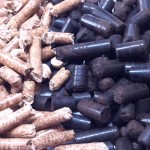 Torrefaction of biomass is expected to reduce biomass trade costs and thus energy costs for the end users. A study conducted by Austrian Bioenergy 2020+in collaboration with the University of Technology and the University of Applied Life Sciences in Vienna aimed at defining technical and cost parameters for the production, fuel properties, supply and end-use of torrefied wood pellets.
Torrefaction of biomass is expected to reduce biomass trade costs and thus energy costs for the end users. A study conducted by Austrian Bioenergy 2020+in collaboration with the University of Technology and the University of Applied Life Sciences in Vienna aimed at defining technical and cost parameters for the production, fuel properties, supply and end-use of torrefied wood pellets.
The findings were used to compare costs along four real-case supply chains for conventional and torrefied pellets:
- A regional chain for supply and use of premium pellets for residential heating in Central Europe;
- An intra-continental chain for production of premium pellets in Eastern Europe and their transportation to Central Europe for small-scale pellet boilers;
- A long-distance chain with production of pellets in Western Canada and shipping to a European coal power plant for co-firing;
- An intercontinental supply from Northwest Russia to Northwest Europe for use in co-firing stations.
+10% net calorific value for torrefied wood pellets and same ash content as standard wood pellets
For the fuel specification, samples provided by European producers were analysed, consisting of torrefied wood chips from spruce and torrefied branches and bark from landscape maintenance, which were compared against the analytical results of a wood pellet sample from spruce. The fuel analyses were conducted according to European standards for solid bio-fuels and measured the total content of carbon, hydrogen and nitrogen, ash content, calorific value and bulk density. Fuel analysis showed that the elemental composition of the feestock is not influenced by the torrefaction process, meaning that the ash content of biomass doesn’t change with torrefaction. On the other hand, an increase of 10% in the net calorific value of torrefied pellets compared to standard wood pellets was observed (on average 5.4 MWh/t NCV for torrefied pellets against 4.9 MWh/t for wood pellets).
Savings in logistics costs possible but long-term outdoor storage still challenging
Besides analyzing the quality of torrefied biomass, cost estimations were drawn based on different technological options and particularly on the experiences gained in concept design, engineering and set-up of a 40.000 t pyrolysis plant in Austria. Transports and logistic costs were also assessed. Results of this assessment indicate that the production costs for the pre-treatment phase are much higher for torrefied pellets than for wood pellets, but they are partly compensated by reduced transport and logistics costs.
A frequent assumption is that torrefied biomass is hygrophobic and stable under outdoor storage conditions. To verify this statement different samples of wood pellet stored in outdoor piles were monitored for several months from January to April 2013, revealing that in fact torrefied wood pellets are less hygrophobic than expected. A pile stored outdoor for 4 months in winter season showed a layer of 50 cm of biomass which was highly degradated by moisture and snow.
Large-scale vs. small-scale combustion
Combustion tests of torrefied biomass in 15KW boilers were also conducted to assess the suitability of this feedstock for small scale heating units. Results showed that the utilisation of high quality torrefied pellets in small-scale pellet boilers is possible with minor adjustments to the stove’s control system, which are required to guarantee optimal and secure combustion behaviour. However the use of premium torrefied pellets for space heating is still more expensive than that of premium wood pellets.
On the other hand, torrefied pellets can be used without major adjustments in large-scale conversion plants and the cost assessment showed that a 10% co-firing rate of torrefied wood pellets in an 800 MWel coal power plant would result in similar or even slightly lower production costs per MWhel than standard wood pellets, when no retrofitting and additional maintenance operations are required. With that in mind, torrefied pellets turn out to be a good alternative for industrial as well as residential users.
This post is based on a paper by Rita Ehrig (Bioenergy 2020+) et. al. presented at the 21st European Biomass Conference and Exhibition. Download the full paper here


